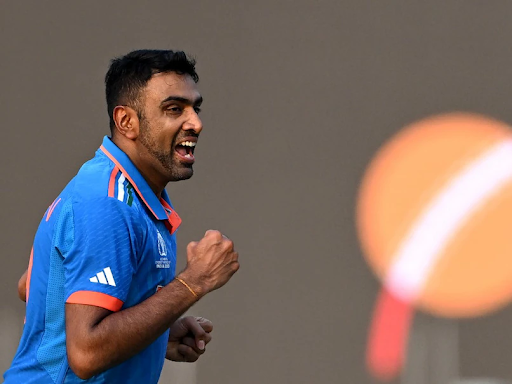Pat Cummins’ execution should be applauded and he bowled his ten overs without a mid-off – R Ashwin

On November 19, R Ashwin was quite positive that India would win the World Cup; India finished as runners-up while Australia won their sixth World Cup with to skipper Pat Cummins’ “tactical brilliance and tactical execution” and this was Ashwin’s analysis of the final, which he discussed this week on his YouTube channel in great detail.
On November 19, R Ashwin was quite positive that India would win the World Cup. However, India finished as runners-up while Australia won their sixth World Cup with skipper Pat Cummins’ “tactical brilliance and tactical execution”. This was Ashwin’s analysis of the final, which he discussed this week on his YouTube channel in great detail.
“Pat Cummins was struggling as an ODI bowler heading into the World Cup. But in the last four or five games leading into the final, nearly 50% of the balls he bowled were cutters,”
Ashwin said.
“In the final – I don’t know how many people explained it on TV – Cummins bowled to a four-five leg-side field like an off-spinner, bowling the stump line. But he bowled only three balls in the six-meter mark or further up on the pitch in his entire ten-over spell. [He] knocked off crucial wickets in the final. The five fielders on the on side were square leg, midwicket, mid-on, deep square leg, and long leg, and he bowled his ten overs without a mid-off.”
Cummins concluded with figures of 2 for 34 and did not let up a single boundary in a field that was primarily leg-side and lacked a mid-off.
The two wickets were those of Virat Kohli and Shreyas Iyer; Kohli played one on while attempting to drag a back-of-a-length delivery to deep third, while Iyer was dismissed by a low bounce on a length ball. The strikes had a significant impact in restricting India to 240 in Ahmedabad.
“Cummins’ execution should be applauded,”
Ashwin said.
“It is easy to plan to bowl to a leg-side field. It is easier to bowl that way in a Test match because the umpires will not call a wide even if you bowl a couple of balls down the leg.
“But to not bowl a wide down leg in an ODI, execute the plans with that field, and not allow batters to drive the ball is brilliant. In my experience, I have seen bowlers go for at least one or two fours with such a field.
“It was the first time I saw a fast bowler bowl to an off-spinner’s field without a mid-off in a one-day game. Tactical brilliance, tactical execution. They had us there.”
The slow pitch for the final was a major reason why Cummins and other Australian fast bowlers used the cutters. Australia had worried on the day of the final that the strip might favor the Indian spinners since it had already hosted the India-Pakistan match on October 14. Everyone was shocked when Cummins, who had called at the toss, decided to field.
When Ashwin ran into Australia’s chief selector George Bailey at the midway point, he would subsequently learn the exact reason behind Cummins’ decision.
“I was looking at the pitch in mid-innings break when Bailey came around. I asked him why they chose to bowl first when Australia generally bat first in finals,”
Ashwin said.
“[Bailey] said, ‘we have played IPL for many years, toured here for bilateral series. As per our experience in India, red soil disintegrates but black soil becomes better to bat under lights. It is tough [to bat] in red soil under lights, too.
“In Lucknow against South Africa, the pitch was a red soil one. Under lights, the ball not just seamed but also spun. Even dew does not have much impact on red soil whereas on black soil, the ball turns in the afternoon but becomes patta (flat) like concrete [under lights]. That is our experience’.”
When comparing the white Kookaburra balls used in the bilateral series and the IPL to those used in ICC competitions, Ashwin also expressed concerns about the balls’ quality.
He said that, in contrast to those used in ICC events, the ones used in bilaterals and the IPL lost shape more easily and absorbed moisture.
“I have observed in ICC events that whether the spinner rotates it or whether a fast bowler bowls the ball lands on the seam and goes on. Whereas in bilateral series or IPL, the ball [loses shape and] becomes like a round vessel, a lemon, or even an egg.
“Sometimes when the ball is kept in a storeroom, it catches a lot of moisture and soaks water and changes shape and changes quality [easily]. If the ball is given in the same quality [as in ICC events] in bilateral series and IPL, it will make a difference, because selections are based on performances in these bilateral series and the IPL. It will be the right test for batters and bowlers.”
On Thursday, the two sides will play again, but in a different format. A five-match T20 International series between Australia and India is scheduled to begin with the first match later on Thursday.
India’s captain for the series is Suryakumar Yadav, while Australia’s captain is Matthew Wade.
Senior pros will presumably be rested for the series, and both teams will likely play a second-string lineup.
The ACA-VDCA Stadium in Visakhapatnam will host the first T20 International.
India squad: Suryakumar Yadav (Captain), Ruturaj Gaikwad (Vice-captain), Ishan Kishan, Yashasvi Jaiswal, Tilak Varma, Rinku Singh, Jitesh Sharma (Wk), Washington Sundar, Axar Patel, Shivam Dubey, Ravi Bishnoi, Arshdeep Singh, Prasidh Krishna, Avesh Khan, Mukesh Kumar.Australia squad: Matthew Wade (Capt), Aaron Hardie, Jason Behrendorff, Sean Abbott, Tim David, Nathan Ellis, Travis Head, Josh Inglis, Glenn Maxwell, Tanveer Sangha, Matt Short, Steve Smith, Marcus Stoinis, Kane Richardson, Adam Zampa.

